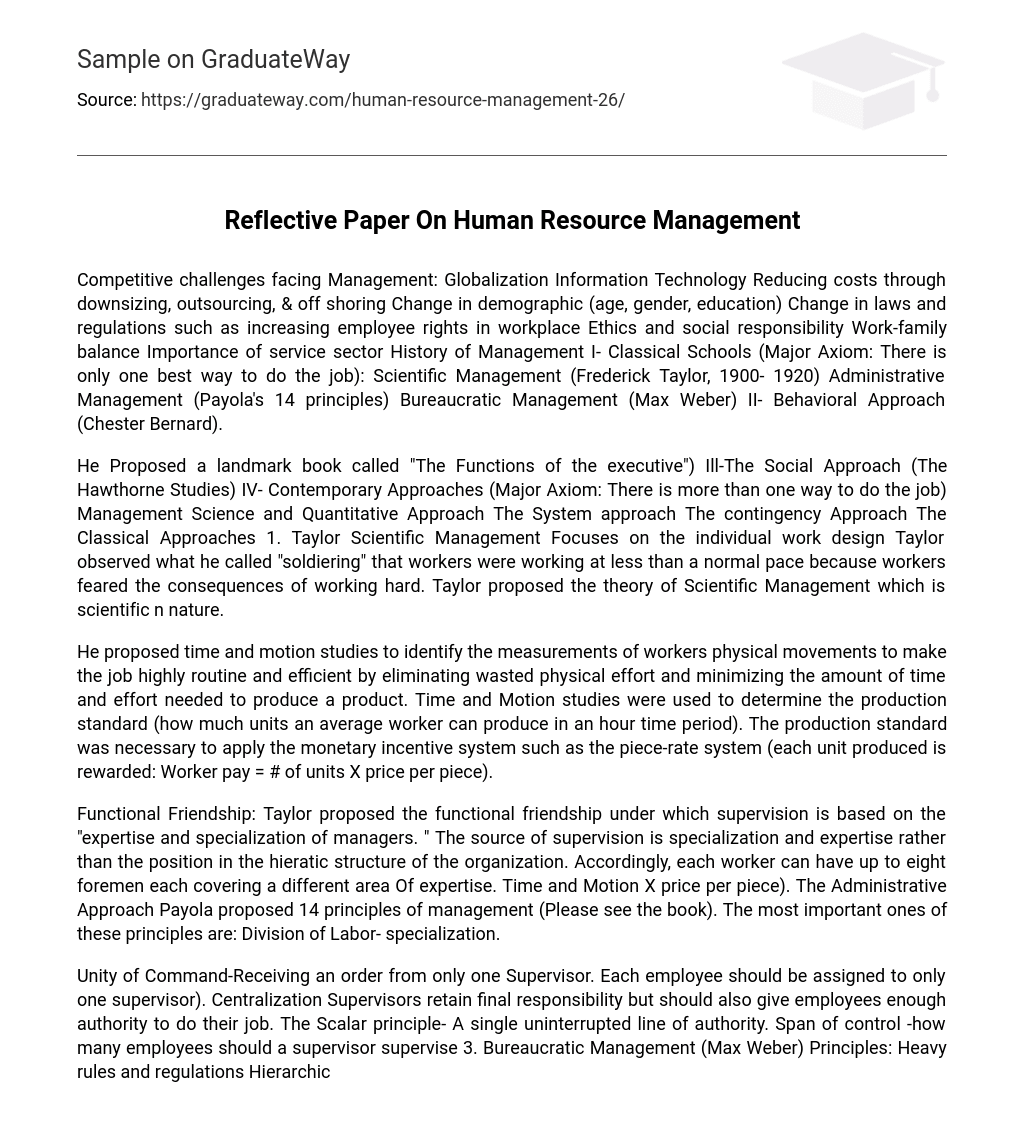Competitive challenges facing Management: Globalization Information Technology Reducing costs through downsizing, outsourcing, & off shoring Change in demographic (age, gender, education) Change in laws and regulations such as increasing employee rights in workplace Ethics and social responsibility Work-family balance Importance of service sector History of Management I- Classical Schools (Major Axiom: There is only one best way to do the job): Scientific Management (Frederick Taylor, 1900- 1920) Administrative Management (Payola’s 14 principles) Bureaucratic Management (Max Weber) II- Behavioral Approach (Chester Bernard).
He Proposed a landmark book called “The Functions of the executive”) Ill-The Social Approach (The Hawthorne Studies) IV- Contemporary Approaches (Major Axiom: There is more than one way to do the job) Management Science and Quantitative Approach The System approach The contingency Approach The Classical Approaches 1. Taylor Scientific Management Focuses on the individual work design Taylor observed what he called “soldiering” that workers were working at less than a normal pace because workers feared the consequences of working hard. Taylor proposed the theory of Scientific Management which is scientific n nature.
He proposed time and motion studies to identify the measurements of workers physical movements to make the job highly routine and efficient by eliminating wasted physical effort and minimizing the amount of time and effort needed to produce a product. Time and Motion studies were used to determine the production standard (how much units an average worker can produce in an hour time period). The production standard was necessary to apply the monetary incentive system such as the piece-rate system (each unit produced is rewarded: Worker pay = # of units X price per piece).
Functional Friendship: Taylor proposed the functional friendship under which supervision is based on the “expertise and specialization of managers. ” The source of supervision is specialization and expertise rather than the position in the hieratic structure of the organization. Accordingly, each worker can have up to eight foremen each covering a different area Of expertise. Time and Motion X price per piece). The Administrative Approach Payola proposed 14 principles of management (Please see the book). The most important ones of these principles are: Division of Labor- specialization.
Unity of Command-Receiving an order from only one Supervisor. Each employee should be assigned to only one supervisor). Centralization Supervisors retain final responsibility but should also give employees enough authority to do their job. The Scalar principle- A single uninterrupted line of authority. Span of control -how many employees should a supervisor supervise 3. Bureaucratic Management (Max Weber) Principles: Heavy rules and regulations Hierarchical structure Division of Labor Rationality Impersonality Staffing by technical competency Life-long career commitment Authority structure -Traditional (Custom). Rational legal (Position). Charismatic (Extraordinary personal power). Outcomes: Effectiveness, efficiency, and consistency. This system is good for large organizations (mass production). Problems: Red tape. Prevent innovativeness and creativity Obsolete technology (technological change can be a problem). People are so busy keeping papers to secure themselves. People are unhappy (alienated). However we need bureaucratic system under certain conditions. II. Behavioral Approach (Chester Bernard) Bernard Proposed a landmark book called ‘The Functions of the executive”).
Bernard argued that the source of power is not the “position” as it is the case ender the administrative and Bureaucratic approaches but the source of power is coming from the “subordinates. ” Subordinates weigh the legitimacy of a supervisor direction and accept the supervisor order if they understand it, are able to comply with it, and perceive it as appropriate given the organization goals. The order will be accepted if it falls within the “zone of indifference” (the zone of acceptance).
The wider the zone of indifference, the wider the acceptance off manager authority. The wider the rewards, the wider the zone. Subordinates weigh their contribution vs.. Their rewards. Sources of Authority Under Bernard, authority is coming from bottom (the people) up not from up down. This theory empowered people and it called behavioral theory because of that Ill. The Social Approach (The Hawthorne Studies by Elton Mayo, 1 924 to 1933) Started by the examination of the proposition that “workers’ productivity would be enhanced by improving lighting. To test this proposition, they randomly picked from the Hawthorne plant nine women to serve as the experimental group (it was subject to various lighting conditions) and nine women to work as the control group (where it was operated under constant lighting, I. E. , no change in lighting). Surprisingly, productivity’ of both groups was improved regardless of the lighting conditions. The unexpected finding was explained by what is now known as the “Hawthorne effect,” The productivity increased in both groups because of the care and concern that those women received from the researchers who conducted the experiment.
This theory emphasized the importance of “human elements and the social factors in the organization” IV Contemporary Approaches (Major Axiom: There is more than one way to do the job) 1. Management Science and Quantitative Approach Focuses on management science and quantitative techniques. Focuses on the placement of mathematical models to solve management problems. Applied certain techniques such as decision tree and Markova chain to business problems. 2. The System approach The system approach emphasizes the interconnection among the elements of the system.
The greater the connection, the greater the effectiveness. Inputs- –Transformation Process-?—outputs Two important concepts related to the system approach: Synergy: The value of cooperation: The whole is greater than the sum of its parts. Entropy: The importance of interdependence among the elements of the system. Is the process by which the system decay (becomes old). Managers must seek feedback from the environment and take appropriate steps to avoid entropy and to prevent failing. 3.
The contingency Approach Woodward Research: Woodward studied 1 00 firms in the U. S. And concludes that firm’s technology seemed to account for differences in success between firms.





